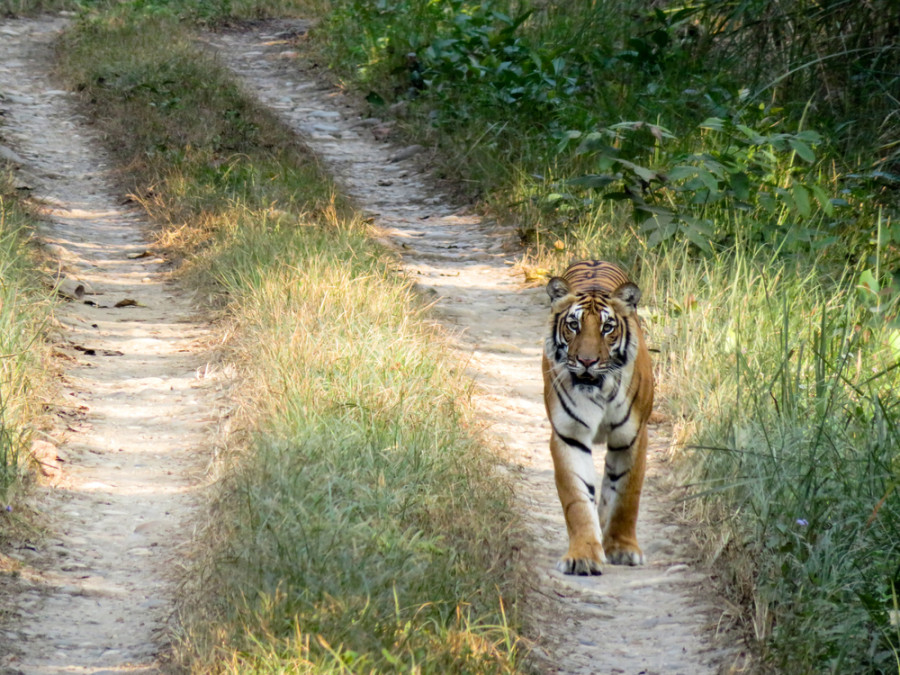Climate & Environment
Chitwan and Parsa can sustain more tigers, says government study
A study on the ecological carrying capacity of tigers has shown that these two parks can support approximately 175 tigers in future.
Chandan Kumar Mandal
In what could be another boost for efforts to increase the population of tigers in the country, a study commissioned by the government has found that Chitwan and Parsa national parks could accommodate 175 tigers in the future.
The ecological carrying capacity study of tigers in Chitwan-Parsa Complex concluded that while 136 tigers can find a home in Chitwan, 39 can do so in Parsa.
The complex is currently home to 111 tigers—93 in Chitwan and 18 in Parsa, as per the latest 2018 census.
“This is a very good sign for tiger conservation in the country,” Hari Bhadra Acharya, an ecologist with the Department of National Park and Wildlife Conservation, told the Post. “There were concerns that the country’s tiger bearing protected areas and forest might not be able to accommodate more tigers in the limited space we have. But the study suggests that there is still a prospect for the population to grow .”
Conservationists had been calling on authorities to carry out the study after the 2018 census showed that the population of the big cats had declined in Chitwan to 93 from 120 recorded in 2013. Some conservationists were worried that Chitwan might have hit the limit in terms of prey and other resources for the tiger population to flourish.
Ecological carrying capacity, the maximum number of species a particular area can host, is calculated on the basis of energy requirements of the species concerned and on the availability of prey.
Acharya, the member-secretary of the nine-member technical committee that conducted the study, said, “The number of tigers has increased in the country. There were questions being raised about how many more tigers can be sustained in these parks.”
“We used models of tiger ecological carrying capacity estimation to measure available prey in the area.”
The 2018 census, which put the population at 235 in the whole of Nepal, also estimated prey density in tiger-bearing protected areas and adjoining forests. But as the data was outdated, the number was re-calculated, according to Acharya.
Tiger prey surveys were carried out between April 29 to May 25 last year across all habitats in Chitwan-Parsa. Trained surveyors visited grasslands, riverine and sal forests as well as the foothills of the Chure to record tiger prey species such as spotted deer, sambar, hog deer and barking deer, blue bull, wild boar and gaur. Transect surveys were conducted in the morning and in the afternoon when all animals are assumed to be active.
“Availability of 20,000 kg of prey would support an adult tiger over a year even when they would consume other co-predators in the habitat eating,” said Acharya. Likewise, an adult tiger on average would kill 50 prey every year as per the prey density model.
The models showed an adequate prey presence in the complex where spotted deer were the most abundant prey species for tigers. According to the study, the ecological carrying capacity estimate, calculated using the prey biomass method, stood at 138 tigers for Chitwan and 39 tigers for Parsa. Likewise, the tiger ecological carrying capacity estimate based on the prey density put 136 tigers for Chitwan and 39 for Parsa park.
Chitwan National Park’s potential tiger density was estimated at 14.5 per 100 sq km compared to 3.81 per 100 sq km reported as per the latest census. Parsa’s potential tiger density was expected to further rise up to 6.22 per 100 sq km from 1.49 per 100sq km as recorded during the last census.
The study pointed out a huge difference in the number of tigers that could be supported by the Chitwan compared to Parsa, despite Parsa covering nearly two-third the size of an area compared to Chitwan. The researchers attributed this to a significant difference in the overall prey density between the two parks.
“The report has shown encouraging signs for further growth of tiger population in these two parks as we have enough food and space to cater to new populations,” said Acharya.
“But there are disturbances in their natural habitat with growing human activities and tourism activities that affects the tiger’s behaviour. They might not use the disturbed area. Habitat management and a dedicated conservation action plan for the Chitwan-Parsa complex is required for their conservation.”



 8.12°C Kathmandu
8.12°C Kathmandu











